Exploring Terrazzo in Dubai: Architectural Insights
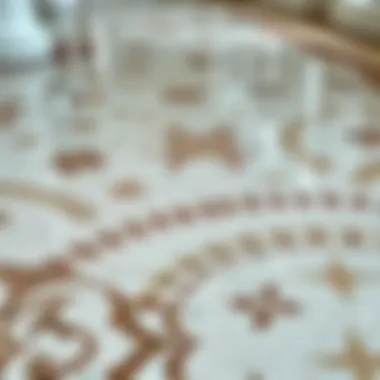
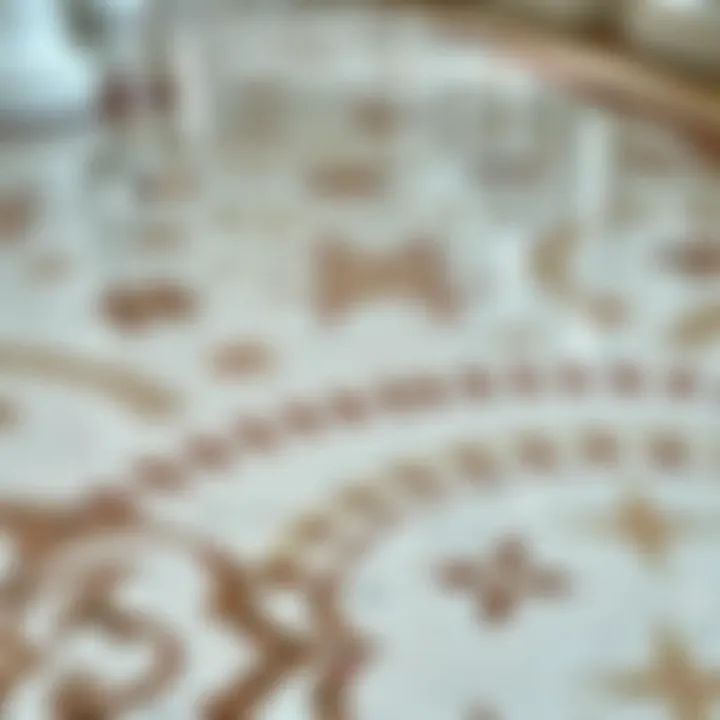
Intro
Terrazzo has been making waves in the architectural landscape of Dubai, a city known for its bold designs and innovative materials. This composite material, traditionally made from chips of marble, quartz, granite, and glass, is not just about aesthetics; it embodies durability and adaptability—the twin pillars of modern architecture. In a bustling place like Dubai, where structures reach for the sky, terrazzo offers a way to ground design with both aesthetic beauty and practical longevity.
The significance of terrazzo in Dubai's evolving architectural scene cannot be overstated. Its historical roots in ancient flooring techniques are juxtaposed against the city’s cutting-edge skyscrapers, creating a blend of the old and the new. The vibrancy of patterns achievable through terrazzo allows for a connection to both cultural heritage and contemporary design trends, making it an ideal choice for a variety of spaces.
As we dive deeper into the nuances of terrazzo, this comprehensive overview aims to equip investors, homeowners, and design enthusiasts with meaningful insights. From unraveling installation techniques to exploring local suppliers, we will dissect every element that makes terrazzo a material of choice in modern Dubai. The subsequent sections will not only detail market trends but will also provide guidance for those considering investment opportunities in this thriving real estate environment.
Intrepid investors and property managers should pay close attention, as understanding these dynamics may well open doors to lucrative opportunities in a market that shows no signs of slowing down. Let's begin our exploration with a focus on the current market insights surrounding terrazzo and how they tie into Dubai's architectural narrative.
The Evolution of Terrazzo in Dubai
The journey of terrazzo in Dubai is like a colorful mosaic itself, reflecting a vibrant blend of history, culture, and modern innovation. Understanding how this unique material evolved in the emirate offers insight not just into its aesthetic appeal, but into the social and architectural transformations that Dubai has undergone. Terrazzo, with its roots stretching back to ancient civilizations, showcases a timeless adaptability that continues to flourish in one of the world's most dynamic cities.
Historical Perspective
Historically, terrazzo has its beginnings in ancient Egypt, where artisans crafted polished marble chips set in lime mortars. Fast forward to the Venetian masons of the 15th century, who refined this technique to create durable flooring suited for both private homes and public spaces. In Dubai, the limestone and marble commonly found in the region enhanced the allure of terrazzo, making it integral to the local architectural language.
As Dubai transformed itself from a small fishing village into a bustling cosmopolitan hub, terrazzo adapted along with it. The architectural boom following the discovery of oil in the 20th century saw a significant uptick in its usage. Developers embraced terrazzo for its durability and easy maintenance, recognizing its potential as a timeless design choice that could withstand the test of time.
Throughout the decades, terrazzo has been a staple in high-profile projects, whether it's the floors of luxury hotels or the pedestrian walkways of urban centers. Its evolution is not merely a story of materials but also a reflection of Dubai's aspirations—flourishing, modernizing, and consistently redefining luxury.
Cultural Influences on Terrazzo Design
Cultural influences play a distinctive role in the design and application of terrazzo in Dubai. The architectural dialogue here is enriched by a rich blend of Middle Eastern traditions and international styles. The geometric patterns common in traditional Islamic art find their way into terrazzo designs, a visual tribute to heritage and craftsmanship.
Furthermore, as Dubai continues to attract a global audience, design trends are also shaped by international aesthetics. From minimalist Scandinavian influences to the eclectic style of contemporary art, terrazzo has become a canvas through which designers express varied narratives, merging the old with the new.
The choice of colors and materials often reflects the local environment. Warm earth tones reminiscent of the desert sand, along with greens and blues symbolizing the nearby waters, create a connection between the interior spaces and the surrounding nature. Such thoughtful integration underscores the significance of cultural narratives in terrazzo design, making each installation not just a surface, but a storytelling medium that connects inhabitants to their environment.
In summary, the evolution of terrazzo in Dubai is marked by a rich historical tapestry and diverse cultural influences. It embodies a harmonious blend of tradition and modernity, illustrating how a material can reflect the essence of a city like Dubai—ever-evolving yet deeply rooted in its heritage.
Understanding Terrazzo: Composition and Properties
Understanding terrazzo is essential to appreciate its role in modern architecture, particularly in a vibrant metropolis like Dubai. Terrazzo stands out not just for its beauty but also for its practicality and durability. This section breaks down the composition and properties of terrazzo, providing insights into its materials and maintenance features that make it a preferred choice for investors and architects alike.
Materials Used in Terrazzo
The composition of terrazzo is a blend of various materials, creating a unique aesthetic and ensuring longevity. Here’s a look at the typical components involved:
- Cement or Epoxy: The primary binding agent which holds together the aggregates. This can be Portland cement or epoxy resin, each offering distinct characteristics.
- Aggregate: This includes chips of marble, glass, quartz, or granite. The choice of aggregate significantly influences the texture and appearance of the final surface. The size and color of these materials can also be customized, allowing architects to play with a lavish range of designs.
- Pigments: These are added to the mixture to create vibrant colors, giving flexibility in design. For example, a rich cobalt blue can be achieved by using specific pigments, which sets a lively tone in interior spaces.
Terrazzo's adaptability in terms of materials contributes to its increasing popularity. It can be designed to reflect local culture or the latest trends, making it a versatile option for various types of spaces in Dubai.
"Terrazzo allows for endless customization, enabling designers to create a unique visual narrative that resonates with the character of a space."
Durability and Maintenance Considerations
When it comes to durability, terrazzo is a hard nut to crack. The materials used in its composition result in a surface that withstands wear and tear remarkably well. Here are some key points regarding its durability and maintenance:
- Resistance to Stains and Damage: The epoxy-based terrazzo is especially resistant to stains, making it ideal for high-traffic areas, such as airports or shopping malls. The cement-based variant, while durable, may require a bit more attention to keep it looking pristine.
- Low Maintenance Needs: Periodic cleaning with a mild detergent is typically enough to maintain terrazzo, and it doesn’t require regular sealing like other flooring options. This low-maintenance characteristic is appealing for property managers who seek ease in upkeep.
- Long Lifespan: When installed correctly, terrazzo floors can last decades. This durability translates to long-term savings, making it a sound investment for residential and commercial projects.
The ability of terrazzo to combine beauty with functionality makes it a worthwhile consideration in Dubai's dynamic architectural landscape. By understanding the materials that make up terrazzo and its maintenance considerations, stakeholders can make informed decisions about incorporating this durable resource into their projects.
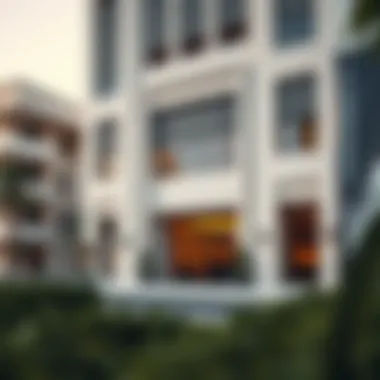
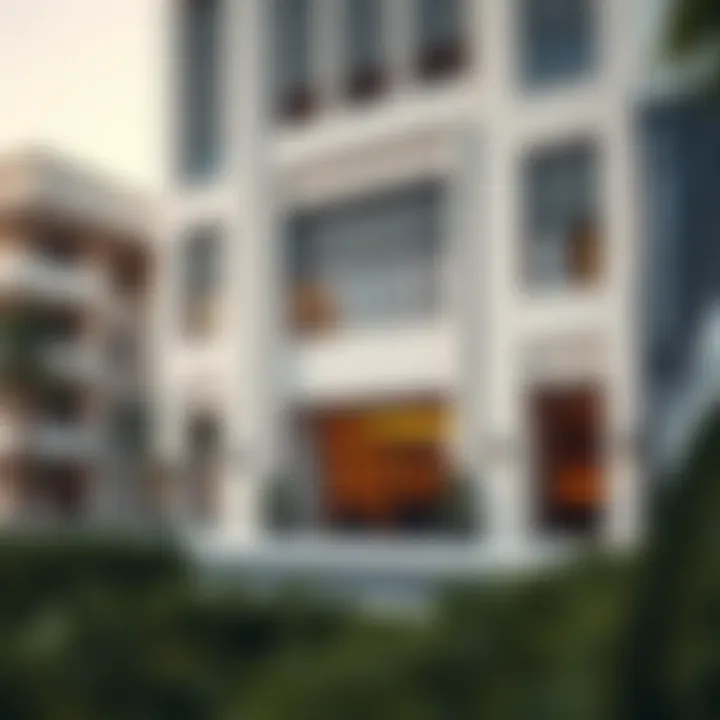
Applications of Terrazzo in Dubai's Architecture
The use of terrazzo in Dubai's architecture is akin to a painter’s palette, rich with versatility and vibrancy. Far from being just another flooring option, terrazzo occupies a prominent place in the aesthetic and functional design of spaces in this modern oasis. Its applications span residential, commercial, and outdoor settings, reflecting not only local culture but also the architectural ambitions that define Dubai. Its aesthetic appeal, combined with remarkable durability, ensures that it remains a preferred choice for various projects, presenting a plethora of possibilities.
Residential Spaces: Elevating Home Design
In the realm of residential design, terrazzo offers an elegant solution that brings sophistication to homes across Dubai. Homeowners are increasingly leaning towards this material for its unique ability to blend with diverse interior styles, be it contemporary, minimalist, or even traditional. The endless options for colors and patterns allow residents to customize their spaces easily. For instance, a family looking for a touch of warmth may opt for soft earth tones paired with subtle flecks of brighter colors to create a welcoming atmosphere.
Moreover, beyond aesthetics, terrazzo provides practicality. Its durability means that it can withstand the daily wear and tear of family life, while its low-maintenance nature means cleaning requires minimal effort. Picture a busy household where spills and messes are part of daily routine; with terrazzo, a simple wipe can restore its gleaming surface. Plus, it’s eco-friendly — many homeowners now choose options made from recycled materials, aligning with sustainable practices and reducing their carbon footprint.
Commercial Use: Enhancing Public Spaces
Terrazzo flooring has made a grand entrance into Dubai's commercial sector, shining bright in buildings, malls, and hospitality venues. Its high durability and resistance to scratches and stains make it an ideal choice for high foot-traffic areas. Take a typical mall in the heart of the city, where hundreds of visitors stroll daily; the last thing anyone wants is a floor that shows every scuff and mark. Terrazzo not only looks stunning but also holds up beautifully against the hustle and bustle of commercial life.
Furthermore, its customization capabilities enable businesses to align the design with branding. Think of a chic café that integrates earthy tones reflecting its approach to sustainability; with terrazzo, they can personalize their flooring in ways that reinforce their identity. The result? A cohesive aesthetic that draws customers in while providing practicality.
Outdoor Applications: Patios and Walkways
The adaptability of terrazzo extends far beyond enclosed spaces, finding its footing outdoors as well. In Dubai, where outdoor living is part of the lifestyle, using terrazzo for patios and walkways enhances outdoor spaces beautifully. The ability to create slip-resistant surfaces ensures safety without compromising style. Picture an elegant terrace leading to a stunning view, intricately designed with vibrant terrazzo patterns that not only capture the eye but also stand up to the climate of Dubai.
In addition, outdoor terrazzo is engineered to resist fading and withstand the elements, making it suitable for various climatic conditions. Homeowners and property managers can rest easy knowing that these surfaces will remain chic and functional without extensive upkeep. Whether stepping out to enjoy a morning coffee or welcoming guests for an alfresco dinner, terrazzo invites comfort and chicness into outdoor settings.
"In a city where design meets innovation, terrazzo serves as a bridge between tradition and contemporary architecture, beautifully enhancing all facets of living spaces."
In summary, the varied applications of terrazzo in Dubai's architecture underscore its significance in both residential and commercial realms. Its unique attributes and aesthetic appeal have solidified its place in this ever-evolving market, demonstrating that while trends may come and go, the allure of terrazzo is here to stay.
Current Trends in Terrazzo Design
In the ever-evolving landscape of architecture and design, terrazzo has firmly established itself as more than just a fleeting trend. In Dubai, a city synonymous with modernization and innovation, terrazzo blends traditional craftsmanship with contemporary aesthetics. Trends in terrazzo design are essential not just for their visual appeal but also for the functionality they bring to various spaces. Local designers and architects are continually redefining this material, leaning towards designs that are vibrant, sustainable, and adaptable to various settings.
Aesthetic Trends: Colors and Patterns
When it comes to aesthetics, the world of terrazzo is exploding with colors and patterns that push the boundaries of conventional design. Gone are the days when earthy tones dominated terrazzo. Today, designers are opting for bold hues—think deep blues, vibrant oranges, and rich greens. These colors can transform a simple floor into a spectacular statement piece. It's common to see terrazzo used in unexpected places, like feature walls, countertops, and even as artistic installations.
"Terrazzo's versatility is its greatest strength—allowing for unique combinations that reflect individual styles or corporate branding."
For patterns, geometric themes are gaining traction. The juxtaposition of angular shapes against soft, flowing designs creates an engaging visual experience. Additionally, the incorporation of recycled materials—often in eye-catching shapes—is not only sustainable but also creates distinctive flair. A growing trend is the use of large aggregates, such as marble chips, which offers a striking contrast against finer grains. Incorporating personalization through custom patterns tailored to specific client needs further enhances terrazzo’s allure.
Sustainable Practices in Terrazzo Production
Sustainability is a critical conversation in any industry today, and terrazzo is no exception. As environmental consciousness grows among consumers, the demand for sustainable practices in terrazzo production has surged. Many artisans and suppliers in Dubai are sourcing local materials, reducing transportation emissions, and supporting local economies. This not only lowers the carbon footprint but also enhances the character of the terrazzo with local flavor.
Another notable practice is the integration of recycled content. By using broken marble, glass, and even concrete from previous projects, producers are crafting terrazzo that's not only exquisite but also eco-friendly. This has led to a significant reduction in waste, giving new life to materials that might otherwise find their way to landfills.
Furthermore, the advancements in technology have allowed for the development of more efficient production processes. By minimizing water usage and optimizing energy consumption, manufacturers are making strides toward greener production while maintaining the material's signature durability.
In summary, as the trends evolve, terrazzo continues to be a testament to both beauty and sustainability. From eye-catching colors and personalized patterns to environmentally responsible production methods, the future of terrazzo in Dubai looks promising. These trends are not just passing fancies but rather a reflection of a deeper understanding of design's role in modern living.
The Role of Local Suppliers and Artisans
Understanding the role local suppliers and artisans play in the terrazzo industry in Dubai is crucial for creating stunning spaces. They are not just facilitators of material delivery but are often the gateway to innovative designs, tailored installations, and authentic craftsmanship. Supporting local businesses not only sustains the economy but also enhances the overall quality and tradition of terrazzo applications in the area.
Local suppliers bring a wealth of knowledge about the materials that best suit the climate and aesthetic of Dubai. From sourcing marble chips that reflect the region's natural beauty to recommending the best sealers that can withstand the intense desert heat, they prove invaluable to both residential and commercial projects. Moreover, many of these suppliers have longstanding relationships with artisans, ensuring a seamless collaborative process from concept to completion.
In addition to providing quality materials, the expertise of these artisans is often where the magic happens. Their skills can transform what might be a simple installation into a work of art. With the blend of modern techniques and traditional craftsmanship, local artisans contribute to the unique allure of terrazzo in Dubai.
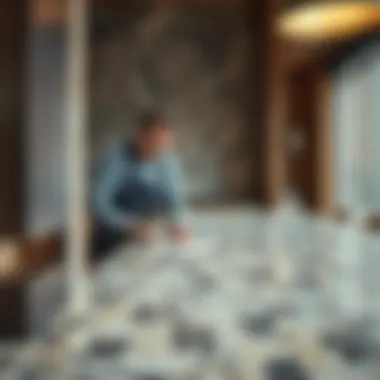
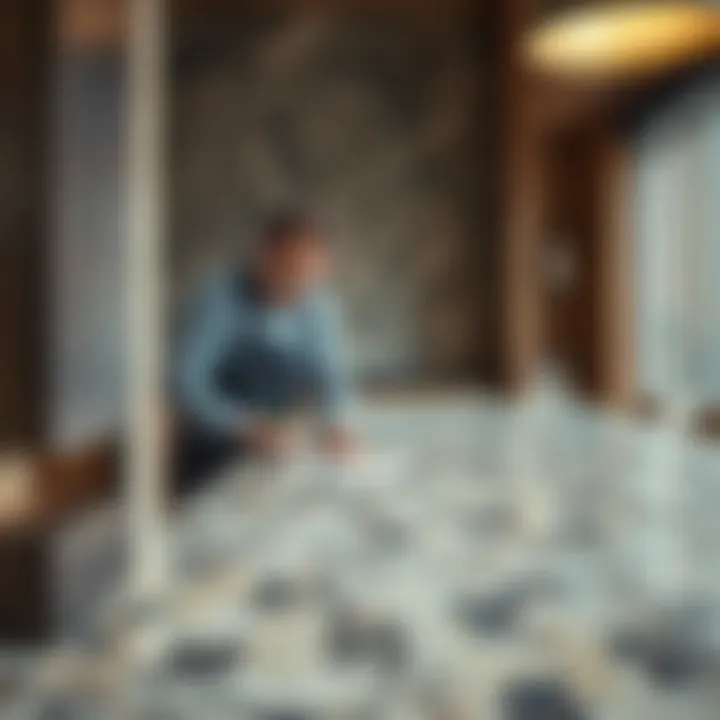
"Partnering with local experts not only elevates project quality but also revives rich cultural heritage through contemporary design."
Identifying Reliable Terrazzo Suppliers
When embarking on a terrazzo project, knowing how to identify reliable suppliers is half the battle. Here are some factors to consider:
- Reputation and Experience: Look for suppliers who have been in the business for several years and have a strong standing. Reviews and testimonials from previous clients can provide insight into their reliability and quality of service.
- Product Variety: A supplier with a diverse range of materials allows for customization in designs. This flexibility can lead to a more personalized final product.
- Communication: Reliable suppliers should be responsive and willing to answer questions. Their willingness to engage can speak volumes about their customer service.
- Certifications and Quality Assurance: Suppliers should be able to provide proof of product standards and certifications, ensuring that their materials are safe and durable.
In a landscape like Dubai, where aesthetics and functionality both hold weight, ensuring your chosen supplier meets these criteria can significantly impact your project's outcome.
Collaborating with Local Craftsmen
Collaboration with local craftsmen is an essential part of creating beautiful terrazzo installations. Here’s why this partnership matters:
- Skill and Craftsmanship: Local artisans often have honed skills that reflect regional design aesthetics and techniques. They’re well-versed in the specific needs of terrazzo, including mixing patterns and finishes.
- Cultural Insights: Engaging craftsmen who understand the local culture can result in designs that resonate well with the community. They bring a sense of identity and authenticity to the installation.
- Problem-Solving Abilities: On-site challenges can arise, and experienced craftsmen possess the problem-solving skills to navigate these smoothly. Their knowledge of the local environment ensures durable solutions that stand the test of time.
Collaboration isn’t just about having the craftsmen do the work; it’s also about including them in the design discussions so that their input enhances the project. This approach not only results in a superior end product but also nurtures a sense of camaraderie and respect within the local craft community.
Installation Techniques for Terrazzo
Understanding the installation techniques for terrazzo is essential, especially in a place like Dubai where this material enhances both aesthetics and functionality in various environments. Terrazzo is not just a surface finish; it's an art form that requires careful preparation and precision in application. The benefits are plentiful: a beautiful, durable surface that can withstand harsh climates, yet it stands to the test of time, making it a smart choice for investors and developers alike.
Preparation of Substrates
Before diving into the actual laying of terrazzo, the preparation of substrates is critical. If the foundation isn't right, everything that follows could crumble or crack under pressure. Depending on whether you're working on a floor or wall, the substrate must be solid, dry, and free from contaminants.
- Surface Assessment: Start by inspecting the substrate for any damages, moisture, or debris. Uneven surfaces should be addressed to prevent future issues.
- Cleaning: A clean surface is a must. This often entails removing all dirt, grease, and old flooring materials.
- Repairing: Any cracks or imperfections must be filled and smoothed out. Some installers choose to use a leveling compound to create a flat surface that is impervious to further damage.
- Moisture Barrier: In high-moisture areas, installing a moisture barrier could preemptively tackle water seepage. Many professionals opt for a layer of plastic sheeting before terrazzo installation begins.
Getting this step right could literally make or break a project. An owner wouldn’t want to see their investment deteriorate due to sloppy groundwork, right?
Finishing Techniques: Polishing and Sealing
Once your terrazzo is laid, the finishing techniques come into play to give it that sought-after luster. Proper finishing isn’t just for looks; it also extends the life of the surface while making maintenance a breeze.
- Polishing: After the terrazzo has been installed, polishing is done using diamond disks to achieve a glossy finish. This process can be tailored based on the desired sheen, whether it’s matte or high-gloss. It’s not uncommon for upscale projects in Dubai to favor a higher sheen due to the luxurious effect it creates in a well-lit space.
- Sealing: To make sure the beauty lasts, sealing the surface is essential. A good quality sealant will protect against stains and water damage. It's advised to apply a penetrating sealant that allows the terrazzo to breathe while repelling moisture and dirt. The sealing process should take place after polishing, as it seals in the shine and adds a layer of protection.
"Proper finishing is key to not just visual appeal, but also to the longevity of the terrazzo surface. This attention to detail is what can set a remarkable project apart from the average."
In essence, by meticulously preparing the substrate and applying precise finishing techniques, installers can deliver a terrazzo surface that not only looks stunning but also performs exceptionally well in Dubai's dynamic environment.
Cost Considerations for Terrazzo Projects
When planning for terrazzo projects in Dubai, understanding the financial implications is crucial. This section explores the essential elements involved in budgeting for terrazzo, focusing on material costs, installation expenses, and the long-term value that this unique flooring option can offer. Adequate cost management not only ensures that a project remains within financial limits but also that quality is not compromised in the process.
Budgeting for Material and Installation
Determining a budget for terrazzo involves assessing both materials and installation. The cost of terrazzo can vary significantly based on several factors:
- Material Type: Terrazzo tiles are usually made from a combination of marble, quartz, glass, and other aggregates. The choice of aggregate significantly impacts the overall cost. Higher-end materials like recycled glass or specialized marble can drive prices up.
- Design Complexity: Custom designs typically require more labor and higher skill levels, leading to increased expenses. If intricate patterns or unique color blends are requested, it can inflate the initial budget considerably.
- Installation Methods: Terrazzo can be poured or set in tiles. Pouring tends to be more expensive because it involves skilled labor and longer installation times. Conversely, tile installation might be cheaper but may compromise on seamless aesthetics.
- Site Preparation Needs: Proper substrate preparation is essential for longevity. If additional layers or leveling compounds are needed, this can add to the overall expenditure.
Setting aside 10-20% of the budget for unexpected costs is wise, as projects often uncover unforeseen measures that need to be addressed.
Long-Term Value Assessment
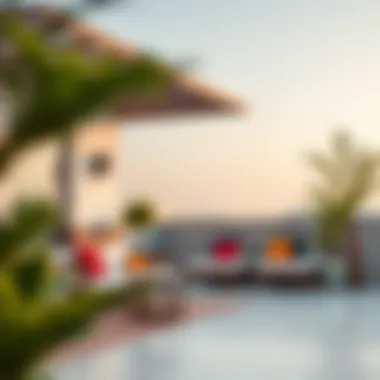
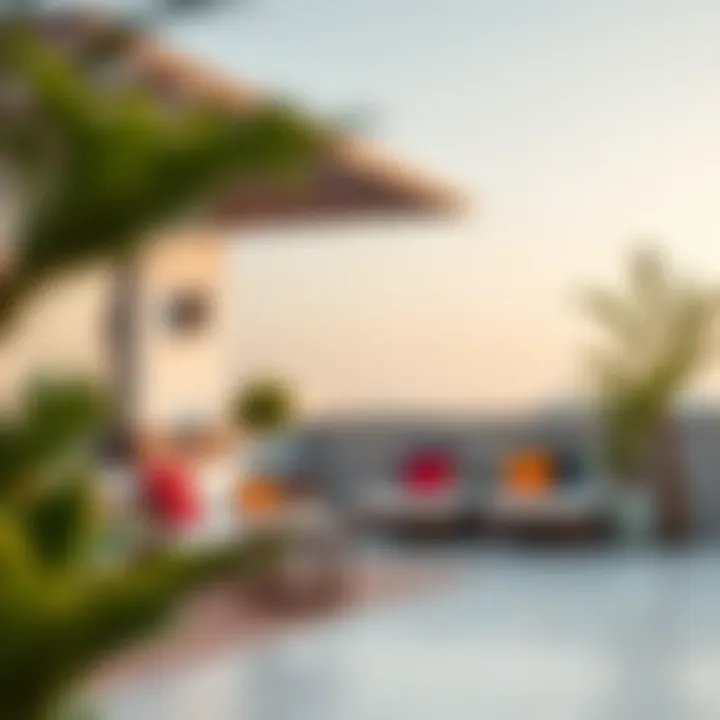
Investors and property managers looking into terrazzo must evaluate the long-term value of their investment. While the upfront costs may seem steep, the durable nature of terrazzo often results in lower maintenance and replacement costs over time.
- Durability: Terrazzo is renowned for its robustness. When properly installed and maintained, it can last for decades, which justifies the initial investment. Scratch and stain-resistant properties also contribute to lower upkeep expenses.
- Energy Efficiency: In the long run, terrazzo can have hidden benefits related to energy efficiency. Its thermal mass allows it to help regulate indoor temperatures, potentially reducing heating and cooling costs in climate-sensitive environments like Dubai.
- Property Value Enhancement: Incorporating high-quality materials like terrazzo can boost property value. Potential buyers often view it as a premium feature, thereby creating a competitive edge in the market.
- Sustainability: With an increasing focus on sustainable building practices, investing in terrazzo, especially recycled options, can speak volumes to eco-conscious buyers. 🌱
In short, while initial costs are a vital consideration, the long-term savings and added value terrazzo can bring to a property cannot be overlooked.
"Investing in high-quality materials today can save both time and money tomorrow."
For those keen on understanding the financial landscape further, resources such as Reddit can offer community insights while official sites like Wikipedia provide foundational knowledge.
Case Studies: Successful Terrazzo Installations in Dubai
The utilization of terrazzo in Dubai is more than just a trend; it is a testament to architectural ingenuity and aesthetic versatility. Case studies highlighting successful terrazzo installations serve as prime examples of how this material enhances both residential and commercial spaces. These installations not only showcase the durability and beauty of terrazzo but also reflect its adaptability to various design visions and settings.
Understanding these case studies is crucial for a few reasons:
- Real-World Application: They provide practical insight into how terrazzo behaves in everyday use, shedding light on its maintenance and lasting appeal.
- Inspiration for Design: By observing successful installations, investors and homeowners can gain fresh ideas for their projects—seeing how colors, patterns, and textures come together in harmonious ways.
- Highlighting Local Talent: These projects often involve local artisans and suppliers, illustrating the collaborative spirit of Dubai’s construction community.
Residential Highlights
A number of stunning residential projects in Dubai demonstrate how terrazzo can transform personal spaces into works of art.
One notable example is the Villa on Al Wasl Road. This project features elegantly crafted terrazzo floors, showcasing a blend of classic marbles and modern colors. The use of rich greens and deep blues in the flooring not only adds to the luxury of the home but also captures the essence of the surrounding landscapes. The homeowners wanted a unique aesthetic that represented their personality, and the result is both inviting and sophisticated.
Another impressive installation is the penthouse at Dubai Marina, where the living areas are adorned with a large custom-made terrazzo piece that acts as a centerpiece. This installation utilized a combination of bright yellows and whites, which radiates light and warmth throughout the open space. It serves as an excellent conversation starter, illustrating how terrazzo can be more than just flooring—it can be a focal point in interior design.
Commercial Projects That Inspire
When it comes to commercial installations, terrazzo shines brightly in various settings, adding character and functionality.
The recent renovation of the Dubai Mall features extensive terrazzo use throughout its public spaces. The flooring integrates intricate patterns inspired by local heritage, bridging the past and present in a modern retail environment. This not only elevates the shopping experience but also tells a story about the cultural richness of Dubai. The integration of sustainable materials in the terrazzo mix further aligns with the mall's commitment to eco-friendly practices.
A standout project is the new office headquarters of a renowned technology firm located in Dubai Silicon Oasis. The flooring design uses bold geometric shapes that enhance the professional image of the company. This installation not only looks good but also has been praised for its durability, standing up to high foot traffic while remaining easy to clean. The office environment feels vibrant and modern, thanks to the lively patterns created with the terrazzo's color palette.
These case studies serve as visual narratives, showcasing the palpable advantages of terrazzo in different environments. The stories of homes and businesses adopting this material offer inspiration for anyone considering terrazzo in their future projects.
"When you choose terrazzo, you're not just selecting a floor; you're investing in an art piece that tells your story."
By exploring these installations, one can see that terrazzo is not merely a construction choice but a canvas for creativity, allowing homeowners and businesses alike to express their identity while enjoying the practical benefits the material offers.
Future Prospects for Terrazzo in Dubai
As Dubai continues to transform into a global hub for innovation and design, the future prospects for terrazzo are brighter than ever. This versatile material, with its unique ability to blend functionality and aesthetics, is gaining traction across various architectural projects. The growing interest in sustainable design, in particular, aligns seamlessly with the inherent qualities of terrazzo, making it a viable choice for the architectural landscape of Dubai.
Emerging Technologies in Terrazzo Design
New technologies are reshaping how terrazzo is produced and installed. Digital fabrication methods, such as CNC cutting, allow for precision that was once unimaginable. This breathes new life into design possibilities, enabling custom patterns and intricate designs to be created with ease.
Moreover, advances in eco-friendly materials are making waves. For instance, the development of recycled glass chips as aggregates not only elevates the aesthetic appeal but also reduces environmental impact. By utilizing waste materials, designers can achieve stunning appearances while supporting sustainable practices. This modern take on terrazzo is appealing to eco-conscious investors and developers looking to align with Dubai’s green initiatives.
"Innovative technologies in terrazzo design are not just enhancements; they redefine the material's role in contemporary architecture."
Market Predictions and Investor Insights
The terrazzo market in Dubai is expecting growth, driven by a resurgence in interest for high-quality and sustainable materials. Real estate developers and investors are increasingly recognizing the value of using terrazzo in both commercial and residential projects. As the demand for luxury properties rises, the unique characteristics of terrazzo—its decorative nature and durability—become significant selling points.
Key Elements for Investors:
- Increased Value: Properties featuring quality terrazzo can command higher prices, as consumers increasingly favor distinctive materials.
- Diversification of Offerings: Incorporating terrazzo into designs can set projects apart in a competitive market, attracting discerning buyers.
- Sustainability Credentials: As environmental awareness grows, investors who support sustainable materials like terrazzo can enhance their brand image and appeal to eco-conscious clients.
In summary, the future of terrazzo in Dubai looks promising. Technological advancements coupled with a sustained demand for sustainability set the stage for designers and investors alike to leverage the versatility of terrazzo. With the architectural scene in Dubai constantly evolving, those who embrace terrazzo are likely to find themselves one step ahead in this dynamic marketplace.















